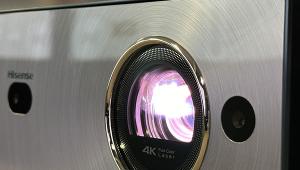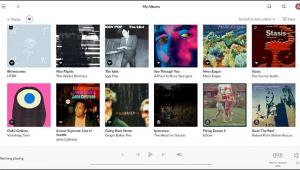Guide To Hi-Res Audio - Hi-Res And The Art of Provenance

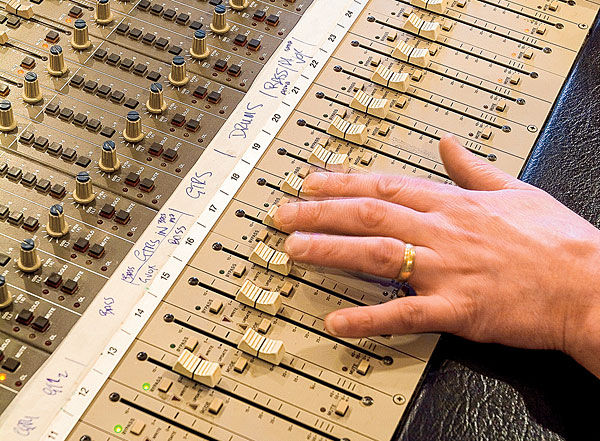
Hi-Res And The Art of Provenance: How the music industry is future-proofing the integrity of hi-res recordings.
“We’re rolling?” The man in the sunglasses, reddish beard and gray fedora eases back in his studio chair, his right hand placed over his left inner elbow. It’s April 2015, and Tom Petty is on YouTube to discuss the benefits of Hi-Res Audio, not long after he and his longtime co-producer Ryan Ulyate finished remastering Petty’s entire catalog in 96-kHz/24-bit for digital formats.
“Hi-res is actually a great thing,” Petty says. “It’s going to change everything for you, musically. You’ll actually hear what we hear in the studio sitting behind the console, which would make me happy. An MP3 is maybe five percent of what I’m hearing in the studio. I’m kicking my ass to give you the highest fidelity there is, and I’d hate for you to miss out on that. Hi-res is the way to go. I want you to be able to hear what I hear when I’m producing the record for you.”

Midway through the clip, Ulyate enters the frame from the left side of the screen, and he and Petty huddle together, nod and smile, clearly enjoying the quality of the in-studio playback of the 96/24 version of “Something Big,” from Tom Petty and The Heartbreakers’ multiplatinum-selling 1981 album, Hard Promises. Recalling that listening session a few months later, Ulyate tells me, “Getting Tom’s full catalog in hi-res helps preserve the legacy of this artist. He’s just trying to make the most exciting thing he can when he’s in the studio. And when we’re in the studio making all of these decisions, we’re listening to the hi-res source. And if that hi-res master has all the stuff going on that makes the artist happy and excited, then we’re doing the right thing. If you want to hear what we heard while we were making the record, hi-res is the exact thing to listen to.”absolute audio bliss experience the Consumer Technology Association (CTA)®, The Digital Entertainment Group (DEG) and The Recording Academy Producers & Engineers Wing—not to mention the producers, engineers and musicians themselves—all want to ensure a wide-scale consumer audience. Last year, a coalition consisting of CTA, DEG, The Recording Academy and the major labels—Sony Music Entertainment, Universal Music Group and Warner Music Group—convened to agree upon a common definition for hi-res music. “The goal is lossless audio better than CD quality, in both sample rate and bit depth, that is the best representation of what the artist intended or has approved,” says Maureen Droney, managing director of The Recording Academy’s Producers & Engineers Wing.
To further hone the definition of hi-res music, the Producers & Engineers Wing is in the process of identifying guidelines and recommendations music creators can adhere to during the recording phase in order to ensure what is known as track provenance, or the integrity and history of the original recording. “These days there can be many participants on a recording project, working in many different locations on different kinds of equipment, so it can sometimes be challenging to identify every step in the process,” Droney says. “What we want to do is provide information and guidelines that will encourage people to make the changes required to conduct their project from start to finish at the highest resolution possible.”
“Track provenance is the declaration of formats the recording has gone through from start to finish,” explains independent producer Chuck Ainlay, who recently completed his term as co-chair of the P&E Wing. Ainlay, a.k.a. “Mr. Digital,” manned the boards for many a high-fidelity recording by Dire Straits and Mark Knopfler over the years, and he’s currently on the subcommittee to define the standards for recording and delivering hi-res masters. “It is vital to the consumer that there is complete transparency so they understand the process from start to finish,” he continues. “This can be very tricky, as not all recording is straightforward these days, with so much of it being done outside of professional recording studios. Also, many archived recordings were done on digital formats that are at sample rates and bit depths at the bottom of what’s considered hi-res, and yet they might be sequenced with newer or even older analog recordings that are at higher sample rates and bit depths within a compilation.”

Understanding and confirming track provenance means diving deeper into the recording minutiae from the literal get-go. “It’s all about pulling back the veil,” observes Marc Sheforgen, COO of Acoustic Sounds, the parent company for Super HiRez downloads. “A lot of hi-res customers value production information, and the more of it we get, the better. The most important questions are: How was the hi-res file created? Did this 24-bit file or this DSD file come from analog tape? Did it come from a 16-bit source? Was it recorded direct to DSD? How did the file arrive for sale in the form that is being advertised? What was the source? That’s what many consumers want to know, and we’d like to tell it to them. But we can’t do it without the content providers telling us this information upon delivery of the product. When the majors deliver us these files, we’d like them to tell us as part of the delivery or metadata how the file was generated. We know the consumer appreciates that information, and it instructs their purchasing decision. We’d like to get this information consistently, and with as many titles as possible.”
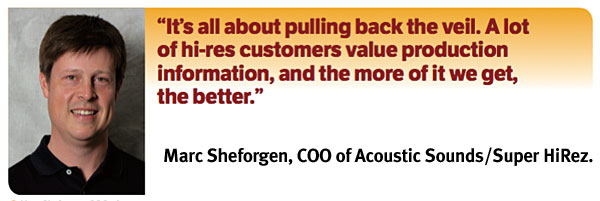
There’s a lot of work yet to be done, but planting a clear track-provenance tentpole is a firm step in the right direction. “We’re in a transitional period. The labels have vast catalog they can repurpose from analog, and that’s wonderful—but we also need to move forward with new releases that are as full fidelity as Hi-Res Audio can be,” stresses Droney. “That requires an education process, and in some cases, it also means an investment in upgraded equipment. But the people who spend their lives creating music also want to create great sounding music. And they want consumers to be able to hear their recordings in a way that reproduces exactly what the artists, producers and engineers heard. We’re now living in a time when that is possible.”
Listen to the Music… All the Time
The good news is, many recording artists are wholly onboard with the idea of delivering hi-res content from the very moment they press the record button—virtually or otherwise. “When we make records, we tend to work with really great equipment, and we make hi-res AIFF files or WAV files that hopefully stand up under scrutiny when listened to on audiophile equipment,” comments noted electronic-music pioneer Moby. “I share this feeling with a lot of musicians: We hope someone, somewhere will take the time to listen to a song or listen to an album in uncompressed Hi-Res Audio.”
Naturally, Steven Wilson, the denizen of creating original hi-res music in surround sound, is adamant about the concept. “All of this hi-resolution stuff is pointless if the mastering sucks,” he notes. “And bad mastering is more of a problem than things being released at CD resolution or even as MP3s. What’s nice about this move to 96/24 is the amount of things now that are coming out in flat transfers with no compression. That is a very, very good development in the history of music. There’s information in those tracks that is simply missing when you listen to a CD.”
David Chesky, co-founder of the hi-res download site HDtracks and the independent record label Chesky Records, emphasizes the importance of technically vetting the source, suggesting you can’t always know from the audible end result what a producer or artist had in mind. “It’s easy to see on a computer screen,” he says. “The waveform doesn’t lie. But in pop, anything goes. If a rap file is too ‘clean,’ for example, it wouldn’t have the authentic urban feel for the genre of music it represents. And if you use distortion, that should be the only thing distorted, not the other things. Hi-res will keep all of this in check, and keep other artifacts out of the music.”
Ainlay echoes Chesky’s sentiments. “Recording and producing music is all about getting the most emotionally charged experience possible. This is not always in line with the greatest fidelity, as distortion, compression and low-bit samplers are often used to great effect to make the music appealing,” he says. “That’s not to say it can’t be recorded in hi-res. My feeling is capturing distortion and other degrading components in hi-res is the most faithful way to preserve what you are hearing in the studio.”
Enabling the breadth of a track in the glory of its full dynamic range is also key. Dynamic compression—the reduction of the loudest and/or the raising of the quietest sounds—is widely used in recordings today, sometimes to the detriment of the experience. But Hi-Res Audio offers the opportunity to preserve dynamics all the way through to the end listener. “I think people need to look at the level as well as the resolution,” says Ulyate. “The thing that makes music feel lo-fi is just how slammed and how compressed it is. If the waveform looks like a sausage, it’s never going to sound that good, even if it’s at 192, or even 384. Put it this way: if I were downsampling something through a brick wall limiter and listening to it with no dynamics, I don’t know how long we’d last in the control room. It wouldn’t be any fun for us sitting there eight hours a day listening to that. That tells you why listening to hi-res is the best source.”
As noted earlier, making sure a track’s original resolution is properly documented is paramount, though, to date, this hasn’t always been done. “Since it is possible to upsample any recording that may have been recorded at lower sample rates or bit depths, there is great possibility that even the record company may be unaware of the original recording’s resolution,” underscores Ainlay. “This is important, because you cannot actually increase the resolution once the recording is truncated in the digital domain to a certain sample rate and bit depth. There are reasons why a recording might achieve higher sample rates in the mixing process if, for instance, it were recorded at 48k, but then mixed through an analog console where EQ, compression and effects were added—and then it is recorded to a machine running at 96k to capture more faithfully the analog output of the console. Again, this is why the track provenance throughout the recording and mastering process is so important.”
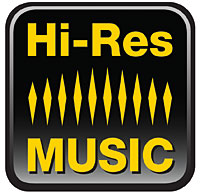 Wanna Take You Higher
Wanna Take You Higher
Standards and recommendations for verifying provenance and creating identifiers for consumers, such as universally accepted logos and track markers, were still being worked through as of late September. But the fact remains: Hi-Res Audio is here to stay, and it’s the best way to listen to music as the artist intended it to be heard. “We’re behind providing the consumer with what the artist feels is the best representation of his work,” agrees Chesky. “At the end of the day, we sell high-end entertainment for those that want more of it to enrich their lives. It’s audio art.”
Wilson encourages recording professionals to follow the hi-res regimen, no matter what. “A lot of people don’t think they can hear the difference, so they figure, ‘Well, most people are going to hear this music on MP3 or on CD at 44.1/16, so what’s the point?’ I think those people are missing a trick here because the audiophile market is growing,” he says. “I figure it’s just a war of attrition, and gradually, more and more people will get into it. Unfortunately, a lot of people who started listening to music on CD have never heard how albums are supposed to sound, or did sound, or should sound, so it’s been great to go back and put that right. In my mind, there’s no reason not to record at 96/24. Even if the difference is 0.1 percent better, why wouldn’t you do it? That’s the bottom line for me.”
Sheforgen goes right back to the source: “It all still boils down to the recording quality,” he says. “Any way you slice it, that’s what matters most, after the performance. If everything’s equal, hi-res blows away CD and MP3. And a bad recording isn’t going to sound good on hi-res. Recording quality trumps everything.”
This is the kind of Ultimately, being vigilant about track provenance ensures hi-res music will reach a broader audience in the days and years ahead. “That’s the road we’re on—to give people the opportunity to hear the differences themselves, encourage and help our members to record at the best resolution they can and continue to raise the bar for everyone as to the quality people are listening to,” concludes Droney. “It speaks to the dedication of the people who spend their whole lives in the studio making recordings sound great. They love what they’re working on, and they love how it feels when it sounds that good. We want to translate that experience to consumers. It’s an exciting thing. When you see people’s reactions at the listening sessions we have after they hear hi-res music in that environment, it makes you optimistic that we are going to get there. Everyone should be able to hear music like this!” Hear, hear, hi-res.

